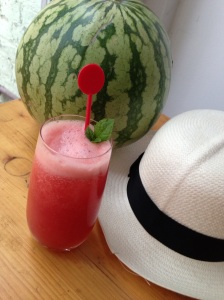 About 10 years ago I ate a rabbit and black olive pie at a now defunct Greek restaurant called Omega in Sydney. I was reminded of it recently when eating in a different Greek restaurant that had the same thing on the menu. Is this a real Greek dish? I tried to find a recipe on the internet but an exhaustive search (i.e. the first page of Google) yielded nothing. So I tried to recreate it. The result was different but still delicious. Please accept my apologies if I have inadvertently insulted a culinary artefact of the Greek culture by my amateur reproduction.
About 10 years ago I ate a rabbit and black olive pie at a now defunct Greek restaurant called Omega in Sydney. I was reminded of it recently when eating in a different Greek restaurant that had the same thing on the menu. Is this a real Greek dish? I tried to find a recipe on the internet but an exhaustive search (i.e. the first page of Google) yielded nothing. So I tried to recreate it. The result was different but still delicious. Please accept my apologies if I have inadvertently insulted a culinary artefact of the Greek culture by my amateur reproduction.
Ingredients
1 rabbit (about 1.2kg), jointed into 8 pieces (ask your butcher to do this if you like)
Some plain flour, seasoned with salt and pepper, and 1tbsp unseasoned
2tbsp butter
2 tbsp olive oil
1 large carrot, finely chopped
2 rashers unsmoked streaky bacon
1 onion, finely chopped
1 stick of celery, finely chopped
75mL white wine vinegar
150mL white wine
1L chicken stock
2 bay leaves
A small handful of kalamata olives, pitted and finely sliced
1tbsp fresh oregano, roughly chopped
1tbsp thyme
70g butter, chilled and cut into small cubes
70g lard, chilled and cut into small cubes
280g plain flour
Salt and pepper
1 egg, beaten
Method
Pat the rabbit pieces dry and coat then in the seasoned flour. Heat 1tbsp each of butter and olive oil in a frying pan over medium to high heat. Brown the rabbit pieces in batches and set aside – they should sizzle but not burn. Do not crowd the pan. Deglaze the pan with the vinegar – it should bubble furiously. When reduced by about half, add the wine and reduce by half. Strain this liquid and set it aside.
Heat a tablespoon of olive oil in a casserole over medium to high heat. Fry the bacon and onion for 5 minutes, stirring occasionally. Add the celery and carrot and cook for another 5 minutes or so, stirring occasionally.
Nestle the rabbit pieces amongst the vegetables, and add the deglazing liquid and the stock. If you are using commercial concentrated stock or stock cubes I suggest making it up with more water than the packet directions say – you will be reducing it later on and you don’t want it to end up too salty. Or you could omit stock altogether and just use water. Add the bay leaves. Bring to the boil, reduce the heat to a bear simmer. Cover, leaving the lid slightly ajar, and simmer until the leg meat is tender – about 1.5-2 hours.
Meanwhile make the pastry. Combine the flour, butter, lard, and a pinch of salt in a food processor until the mixture resembles breadcrumbs. Tip into a bowl. Gradually add up to about 3-4 tablespoons of ice cold water whilst mixing with your other hand, until the mixture comes into a ball. Be patient. You will not believe the mixture will come into a ball, but it will, and you will regret adding too much water once it does. Shape into a fat disc, wrap in cling film and chill for at least half an hour. Do not skip this step. It makes the pastry easier to roll.
When the rabbit is tender, remove the rabbit pieces and put to one side. Strain the cooking liquid into a jug. Allow the fat to rise to the top and any “bits” to settle at the bottom. Skim off the fat and strain again into a clean pan, leaving behind the bits. Boil hard until reduced to about 500mLskimming any scum that rises as you go along. In a separate pan make a roux by melting a tablespoon of butter, adding a tablespoon of plain flour, and cooking for a couple of minutes, stirring frequently. Pour over the reduced cooking juices and stir until it thickens, making a good gravy.
When the meat is cool enough to handle, using your hands, take the rabbit meat off the bone and shred. Rabbit is absolutely full of bones so be careful (a) to get into all the nooks and crannies to get the meat out and (b) to make sure no bits of bone get into the flaked meat Mix in the olives, oregano and thyme. Chill until you are ready to assemble the pie.
Grease a 22cm pie dish (or round cake tin). Cut off ¼ of the pastry and put to one side. Roll out the remainder into a circle and line the pie dish. Put the pie filling into the pastry. Pour over enough gravy to come almost to the top of the meat (keep any left and serve with the pie). Roll out the smaller piece of pastry into a lid and lay over the top. Press down on the edge to seal the pastry and trim off any excess. Cut a few air holes in the lid and, if you wish, decorate with the spare pastry. Glaze with beaten egg.
Bake for 45 minutes at 200C (conventional) or 180C (fan). Rest for 10 mins before serving. I like serving skordalia as an accompaniment. The pie is also excellent cold, eaten with mustard or chutney (as I am doing now).












